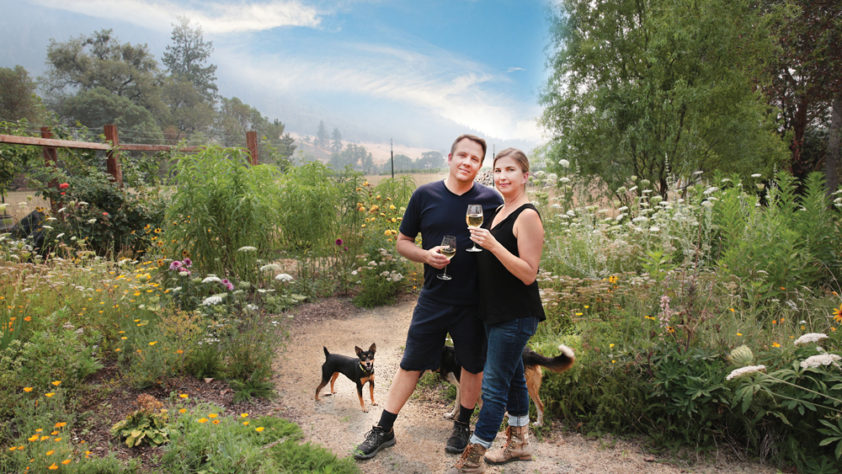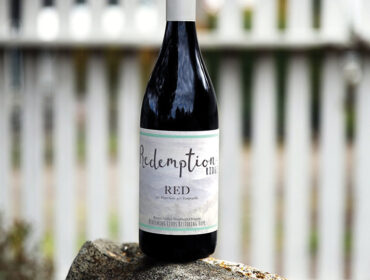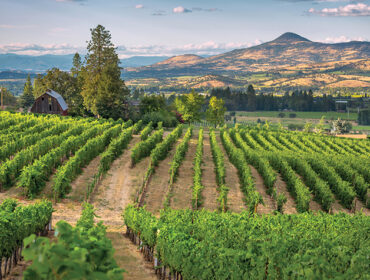
Wooldridge Creek’s Gardens Capture the Spirit of the Place and Its People – by Rhonda Nowak
Standing tall in the wildflower and pollinator garden at Wooldridge Creek is a signpost that reads “May Peace Prevail on Earth” in English letters and Chinese characters. It’s certainly a fitting message for the tranquil ambiance of the colorful garden and the hillside vineyards and winery that overlook the lush Applegate River Valley.
Although the garden appears still, it is actually teeming with life and activity. That’s because the flowers, herbs, shrubs and fruit trees have been planted with regard to their unabashed seduction of pollinators—hummingbirds, butterflies, bees and other beneficial insects.
“We want visitors to experience the garden as a way to get a sense of what we’re about,” said Kara Olmo, co-owner of Wooldridge Creek along with her husband, Greg Paneitz, and vineyard founders, Ted and Mary Warrick.
The pollinator garden, planted in 2017, does, indeed, reflect Wooldridge Creek’s commitment to organic farming and stewardship of the land, wildlife and local watershed. The entire farm—flower garden, vegetable beds, vineyards, winery, creamery, charcuterie, even the barnyard animals – are managed as an interconnected holistic system, which helped Wooldridge Creek earn Salmon Safe and LIVE (Low Input Viticulture and Enology) certifications.
No herbicides are used anywhere on the farm, and the soil in the gardens and vineyards are replenished by composting green waste, food scraps and manure, the latter which is graciously supplied by the farm’s goats, chickens, “Waffles,” the mini-donkey and “Pancakes,” the miniature horse.
Although grapevines are self-pollinating, Kara noted that pollinators are an important part of the local ecosystem “and we want to see them thrive,” she said. The pollinator garden is located next to the parking area near the winery crush pad so visitors have easy access to the vibrant display of annuals and perennials that help sustain pollinators all year round.
Last year, the garden site was just a bunch of weeds, said Wooldridge Creek’s Tony Antonov, who planted and tends the flowers with his wife, Marinela. They started with 100 plants provided by Goodwin Creek Gardens of Williams. Since then, the Antonovs have planted hundreds of additional wildflowers and perennials, along with several fruiting trees and shrubs: Asian pear, Italian plum, sour cherry, peach, fig, kiwi, jackfruit, thornless blackberry, raspberry and elderberry.
Adjacent to the flower garden, Tony also tends a kitchen garden with 10 raised beds filled with a wide variety of vegetables and herbs that everyone on the Wooldridge Creek team is welcome to pick for their own use. These include: tomatoes, tomatillos, cucumbers, peppers, peas, dill, onions, chives, leeks, potatoes, artichokes, melons, strawberries, asparagus, lettuce, chard, kale, cabbage, squash, pumpkins and more.
Some of the produce from the kitchen garden is used in the cheese, meat and vegetable creations that come from Wooldridge Creek’s creamery and charcuterie.
Tony designed paths of decomposed granite throughout the gardens so visitors can wander around and enjoy the sights and sounds of organically-grown flowers and produce that capture the spirit of Wooldridge Creek. “I like to see people walking around with a glass of wine, enjoying themselves,” Tony said. “Who doesn’t get happy in a garden?”
Visitors to Wooldridge Creek’s wildflower and pollinator garden shouldn’t expect manicured beds, but they can anticipate catching a glimpse of a variety of butterflies, bees and other pollinators that are commonly found in the Applegate Valley.
Why are pollinators attracted to specific plants? Flowering plants have adapted colors, scents and shapes that assist them in continuing their species. For example, asters, coneflowers and verbena draw bees, butterflies and hummingbirds with their irresistible smell of nectar. Flowers we see as yellowish—coreopsis, sunflowers, Rudbeckia—appear blue to bees, a color they apparently think is sexy in the same way we associate passion with red. Broad flower heads, like that of yarrow, serve as handy landing pads for insects. Although toxic to humans and pets, milkweed is the only plant the larvae of Monarch butterflies will eat.
Here’s a list of 25 wildflowers and other annuals and perennials growing in the garden at Wooldridge Creek. The list demonstrates the diversity of beautiful flowering plants that attract pollinators and grow well in the Applegate Valley.
Asters
Astilbe
Beardtongue (Penstemon)
Bee balm (Monarda)
Black-eyed Susan (Rudbeckia)
California poppy (Eschscholzia californica)
Coneflower (Echinacea)
Coreopsis
Cowslip primrose (Primula veris)
Dahlia
Foxglove (Digitalis)
Gladiolus
Goldenrod (Solidago)
Hyssop
Lavender
Lupine
Mint (Menthe)
Milkweed (Asclepia)
Oregano (Origanum vulgare)
Red Valerian (Centranthus ruber)
Shasta Daisy (Leucanthemum x superbum)
Sunflower (Helianthus annus)
Sweet alyssum (Lobularia maritima)
Verbena
Yarrow (Achillea millefolium)
©Southern Oregon Wine Scene – from the Spring 2019 issue
Photo ©Steven Addington Photography
Related Post
RoxyAnn Winery–Making a Difference with Redemption...
Update to this article on 07/29/21 – “… the Board of Directors of Redemption Ridge have made the difficult decision to clo...
Awen Winecraft: An Inspirational New Reason...
As if you needed another reason to visit historic Jacksonville, now there’s another draw—Awen Winecraft’s new tasting room located at ...
Rogue Valley Rising – by Valerie...
MEDFORD, OREGON’S star is rising on the world stage as it rapidly becomes a top destination for connoisseurs of fine wine and for enthusia...




